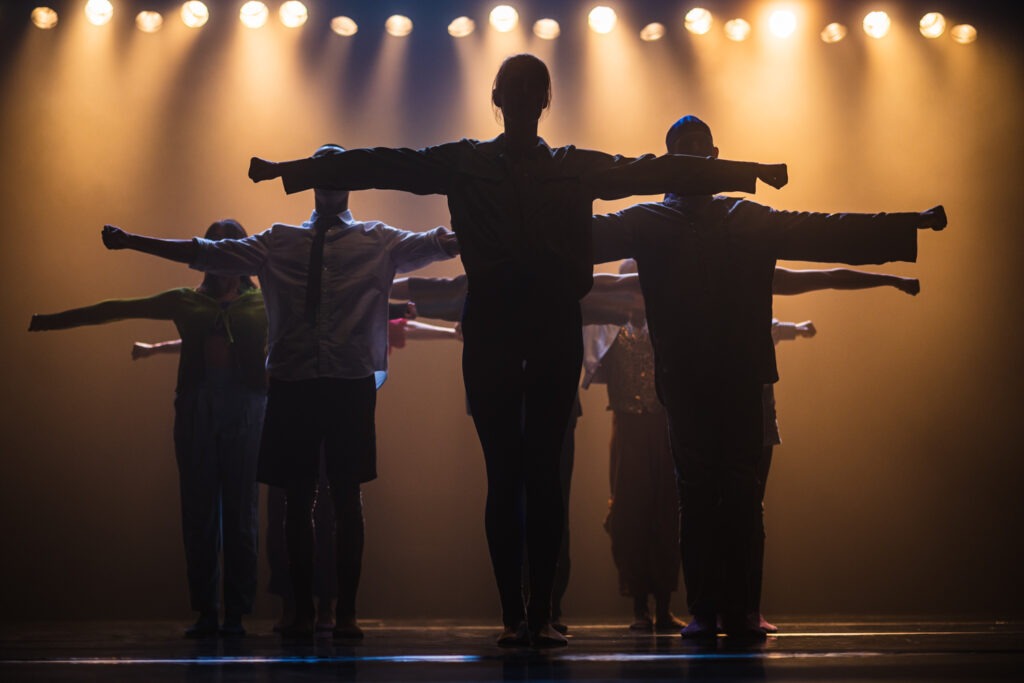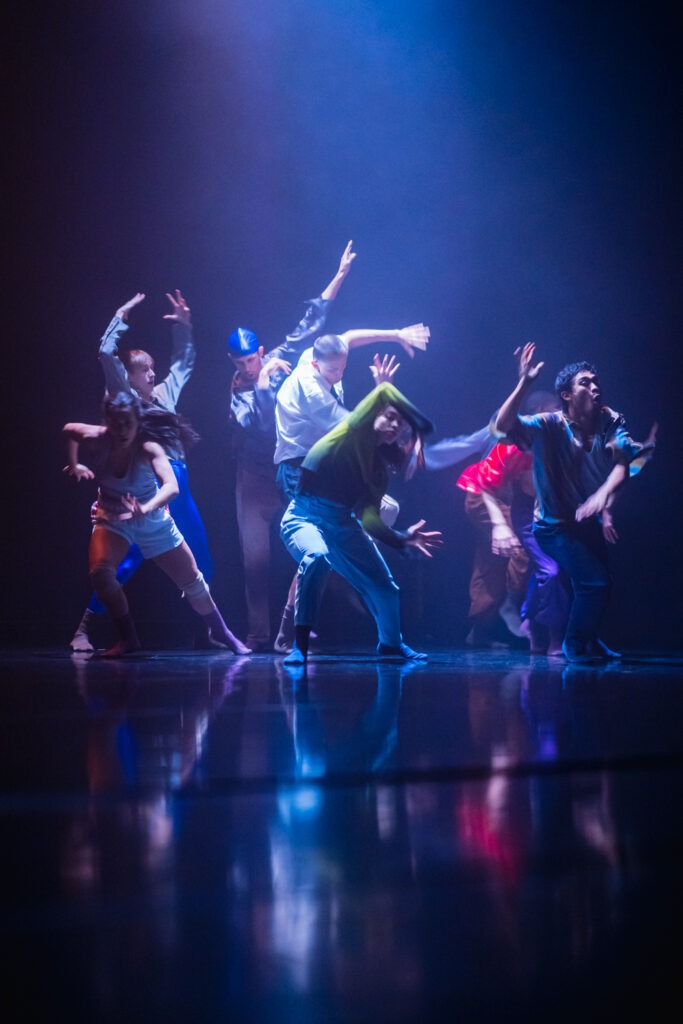The Mesmerising Stage Organism that Swallows the Audience
By Peter M. Boenisch
After Bora Bora celebrated their 5th birthday in 2017 by bringing Shechter’s company to Denmark, the Aarhus’s dance house now opened its Move Your Mind festival with “Shechter II” – his company’s two-year training programme for emerging dance talents aged 18 to 25 that now presents its third cohort with the piece Contemporary Dance 2.0.

It seems somewhat insufficient to call Hofesh Shechter a choreographer, since the music and sound scores that the Brighton-based Israeli megastar of the contemporary dance scene composes himself are just as vital a part of his uniquely energetic stage creations. Perhaps his works are therefore an invitation to rethink which ‘bodies’ we talk about when we speak of choreography, a word whose Greek origin signifies the ‘writing of the body’. In Shechter’s choreographies, he certainly writes with much more than his performers’ bodies. There is the impulsive music. There is the precise lighting that both forms the scenic space and sculpts the dancer’s bodies through its mix of shadow, profile spots and flash effects. And there is the mesmerising, carefully accented and cleverly shuffled movement patterns that characterise Shechter’s choreographic language. All these elements merge into a single organism – an affective stage body whose vitality confronts, enthrals and outright swallows the audience.
Batsheva trademarks
Shechter had created this work’s 1.0-version for the Gothenburg ballet, where it was shown in a mixed bill with a piece by Sharon Eyal, the other, equally riveting offspring from Israel’s national dance company, the Batsheva. That company’s unique trademark style is immediately tangible in the work of both choreographers: a mixture of popular folk dance traditions with modern dance elements and above all its recent transformation through the Gaga-technique, an original invention by Batsheva’s house choreographer, and mentor for Shechner and Eyal, Ohad Naharin.
Gaga reconfigures the Modern Dance focus on the energy centre around the navel by extending it to the entire kinesphere, and from there even further into the space. While Modern Dance anchors the body in its relation to gravity, Gaga creates centre-less, multi-layered movement that seems to define its own dynamic space, with no hierarchy between centre and extremities either. It is based on visceral, sensoric impulses and intuitions, not on visual patterns, emotional expressivity or the counting of a beat.
Shechter uses this solid technical foundation to shape his own resonant and popular, or perhaps rather democratic, approach to contemporary dance. For him, there is no question that the ‘dance art’ one encounters in a theatre such as Bora Bora should be just as intuitively enjoyable and invigorating as going clubbing, attending a pop concert, or working out in the gym. He tackles the conundrum that many find ‘dance art’ intellectual and difficult, whereas it seems most natural to move, train and shake our bodies in our leisure time. He does so through both the spellbinding atmosphere of his performance events, and the extensive education work with schools and youth institutions across the UK so anyone can do, learn and appropriate the ‘Shechter moves’ as the company now refers to them.
Spellbinding movement in 5 Acts
Contemporary Dance is a perfect introduction to this Shechter universe. The first of the piece’s five acts is an exposition of the basic formal principles. Always focused towards the audience, the 8 dancers engage in sharply contoured ensemble movement patterns, where the alternation of synchronicity and structured variations continuously reshuffles the group’s configuration as well as the bodies’ relations to each other and to the space. All maintain an exact, mathematically calculated precision and thus also a captivating flow throughout. Arm and foot gestures define the outer skin of the physical figuration that the ensemble forms and with which it commands the stage.
Sections with minimal movement, such as rolling a shoulder or performing nodding jolts of the head, contrast with the dominant high-speed synchronic swings and shifts in other moments. Both kinds of movement completely absorb the spectators’ attention. Part I called ‘Pop’ is followed by Part II ‘With Feelings’: now the ensemble regroups and orbits through the space in ever shifting pairs. As a highpoint in Part III, titled ‘Mother’, Shechter offers a mini-summary of his pivotal opus magnum called Political Mother, which he keeps restaging and reworking since its original creation in 2010 in ever new permutations. What was originally breathing the liberating political spirit of the Occupy and Arab Spring protests of the time, has acquired new doubtful resonances with the growing right-wing exploitation of protest and the social need for collective resonance in an age of precarious economic and cultural singularisation.
The contrast of the collective and the single individual in his white shirt who shapes and at times falls out of the group context, at once oppressed outcast, then manipulative leader figure dominating the others, drives the choreographic development. In the soundscape, one makes out loops on repeat of equally ambiguous exclamations, “I’m so happy” or “I want it”, which at the end turn into a shouted “Motherf****”, as all come together in a ‘mother group’, holding hands. Shechter leaves the equivocal nature of these group and mass dynamics open for reflection.
Throughout the first three parts, his soundtrack marches on in its hypnotic, tribalistic percussivity, while we begin to discern echoes and repetitions of recognisable movement motifs in the continuously, never ending flow of action. Shechter loves these rapid switches, similar to jump cuts in a video, or perhaps like Tik-Tok clips. Sometimes there are brief blacks between these scenic fragments also precisely timed with the music’s beats. Other times the light setting suddenly changes to cut and reignite an ongoing movement phrase right in its middle. These constantly shifting impulses certainly resonate with the tireless speed and accelerated attention spans of contemporary social media natives.

Yet, the choreographer equally caters for the more conventionally minded audience members, not least in Part IV, ‘Contemporary Dance’, set to one of the most emblematic classical compositions, Bach’s Air. Now, no more ‘Shechter moves’, no more Shechter drums: instead, a pastiche of vignettes from contemporary choreography in its rarely challenged embrace of classical music. Van Manen, Bausch, De Keersmaeker, Graham and Kylian, and a bit of Forsythe, too. They all make an entrance in this tribute that reveals itself as a parody of all the choreographic clichés every dance student is forced to work through in their training. Now then is the time for clearly gendered pair sequences, for the lifts, for waving arm circles, pantomimic hand gestures, floor patterns which the bodies write onto the space, and for a choreography that has the bodies visually illustrate the sound of the instruments. And eventually, there is even the iconic Café Müller jump-and-drop repetition from the Pina Bausch piece, when the male dancer time and again does not catch the female who throws herself onto him, and who falls to the floor again and again.
Shechter puts all these bits and pieces from 20th century dance history into his own choreographic particle processor, which impatiently zaps through the citations, combining them through the quick switching and relentless shifting into a somewhat absurd and alienating collage of staples and spectatorial expectations. Above all, this section highlights the utter contrast to Shechter’s way – while at all times maintaining the supple dynamic flow that characterises his atmospheric stage body.
Their ways
Shechter’s ultimate cleverness is brought home in the finale in Part V, “The End”: ‘The end is near’, Frank Sinatra begins to croon before the final curtain – and yet we see the exact reprise of Act I, realising that the throbbing tribal beats from earlier followed the same rhythmic structure as the melodramatic My Way. And by now, we no longer only equate this with Hofesh’s way alone, but with each of the eight dancer’s unique, personal ways, to whom we got accustomed over the preceding hour.
With all its rigorous and inexorable synchronicity, Shechter’s choreography machine never produces brainless uniformity to be merely reproduced and replicated; it cannot be performed without being sensed and lived. The formally strict choreography thus serves as a channel for letting individuality shine, which the colourful costumes and the pronounced diversity of the ensemble further bring to the fore. In Shechter’s work, there is no corps that simply decorates the stars from the fringes, nor is there a fascist, anonymous mass. Here, everyone is equal and equally enabled – yes, part of a big machine, but also a core organ within a smoothly gliding, very healthy mega-body that moves minds as well as adrenaline and endorphines.
Contemporary Dance 2.0 premiered in Vicenza in March 2022 and continues its European tour through France, Italy and Switzerland in the coming months.
Dancers: Tristan Carter, Cristel de Frankrijker, Justine Gouache, Zakarius Harry, Alex Haskins, Oscar Jinghu Li, Keanah Faith Simin, Chanel Vyent
Choreography and Music: Hofesh Shechter; Lighting: Tom Visser; Costumes: Osnat Kelner
Bora Bora’s Move Your Mind Festival presents further guest performances by Liliana Barros (POR), Ásrún Magnúsdóttir (ISL) and Mette Ingvartsen (DK/B) until 25 November.
Peter M. Boenisch er professor i dramaturgi ved Aarhus Universitet. Han er oprindeligt fra Tyskland og bor i München og Aarhus.
